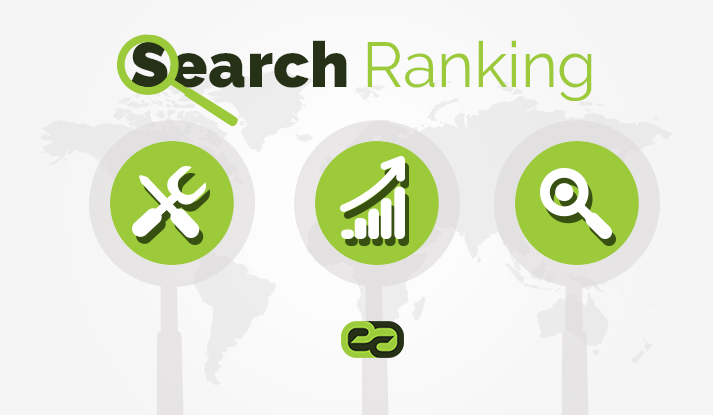
Key Steps on How to Improve Search Ranking Using SEO tools
Digital marketing is often difficult because you will face many challenges in order to rank a company website using effective keywords on search engines and generate much needed traffic. There are so many tasks to do in digital marketing but the core tasks are usually optimizing on-site content for search engine algorithms and getting links from the best keywords, which is quite overwhelming and very difficult to accomplish.
Today, search engine algorithms have developed a smart way on how they rank websites. These algorithms prioritize websites with high quality links rather than those with only massive quantities. However, digital marketing may have made it difficult for smaller businesses to compete with the larger brands, which have much bigger advertising budgets that can be used to generate outstanding contents and links in better sources at a massive scale. There is still a way for smaller businesses to compete with the giant corporations when it comes to search engine optimization and generating traffic.
Small businesses, which are struggling in SEO and digital marketing, have the option to use link analysis tools that can improve search ranking through competitive analysis. There are many choices of tools that can allow you to create effective keyword analysis such as Majestic SEO, Ahrefs, SEMRush and Moz. Regardless of the tools you use, you should be following this simple 5 Step Process to gain success in SEO. If you do everything right, then you can expect a gradual increase in search engine traffic in your website. Here are the key steps on how to improve search ranking using link analysis tools.
Step 1: Defining Keywords That Increases Traffic
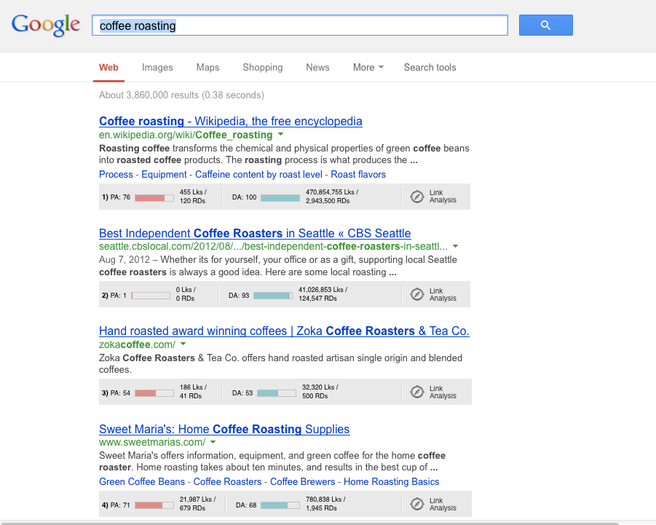
This first step is one of the most important processes that can bring so many benefits for your business. In order to define your keywords, you can start by thinking about the intent of the user as well as what they are trying to accomplish when searching for an individual keyword. You can write down a set of terms that have appropriate user intent behind them. It can be trying to get the user to read an article, download a product, or request for a quote. You should always consider the intent when targeting the keywords. This is to make sure that the audiences will actually follow through with the desired action.
You have to remember that there are thousands of businesses, which are also actively trying to rank up using some of the keywords that you’ve already chosen. If you are just a startup business, there is no way that you can beat a Fortune 500 brand for the top position of a keyword that produces thousands of visits in a month. Google is known for showing the most authoritative sites for relevant queries so this practice reveals that your new business is not as authoritative as those leading businesses that are already established for many years. However, this fact shouldn’t bring you down because there are still a lot of opportunities for you that you can take advantage of.
In order to gauge the difficulty of your keywords, you can start with a tool like Mozbar. If you don’t want to use a tool, you can just use simple common sense. You can look for websites that have high rankings for the keyword in question and see how authoritative they are. If you are using Mozbar, you should check for the domain authority and the number of links each page has pointing to it. You have to remember that the higher the authority and number of links, the more it will be difficult for a page in your website to get in and displace this result.
You have to take note of the ranking top 10 domains for the keywords you are targeting because you will need this information when you come to step 2.
Now that you have an idea about the user intent and difficulty, you can now consider the individual keywords that you really want to use. During this phase, it is very important to bundle each individual keyword into a category, keyword set or topic, but it is really up to you on what you want to call these bundles. Ranking for a specific individual keyword is not realistic, so it would be much better by grouping relevant keywords into a package of 10 or more sets. By doing this, you can ensure that each page you want to rank in search engines target a keyword set instead of just one specific keyword. This process, which may look counter-intuitive for others, can deliver success through SEO because each page will ultimately rank for long tail variations of similar keywords.
Here are the things that you should consider for Step 1:
- Always consider the user intent
- Evaluate keyword competition
- Check for the difficulty of keywords
- Find relevant long tail variations
- Create several keyword sets
Step 2: Finding Your Competitor Sites

Once you have completed Step 1, which is quite difficult and involves so many tasks, you will find that Step 2 is much easier and enjoyable to do. This step involves broadening your knowledge and understanding of the competition you will be facing. With your list of potential keywords, you now have a clearer perspective of the difficulty of ranking your good keywords but you still do not know how you can have the types of links that will make you rank higher and beat the competition.
In Step 1, you saw some of the sites ranking in the top 10 for keywords that you want to use. However, if you are only using Google search to do this, you are just limiting your search to a small subset of the competition you will face. Doing a Google search will just provide you with results that are only specific to your location. If your business is targeting a wider area that is larger than the local reach in your personal search, you need a bigger set of data that encompasses the areas you want to target.
In order to get this bigger set of data, you can use a tool that can provide you with the average national results across the US. One highly recommended tool is the SEMrush, which can work in other countries such as the UK, Australia, Germany and France as well as other international markets. This tool is very useful if you want to check your competition outside the country and it will not limit you to US specific search results. SEMrush is easy to use if you want to national and international competitors. All you have to do is enter a keyword into the SEMrush and it will immediately show you the “organic search results” at the bottom of the Keyword Overview Report.
By following this step, you can now add new sites to your long list of ranking competitors. You will need this large catalog of competitors when you are already on Step 3. This process is better than just doing Google search, even if it takes a bit more time because it will really save you a lot of trouble in the future and guarantee your website to get much needed visibility on search engines across different locations.
Important things to consider for Step 2:
- Use Google to check sites that has high rank for specific keywords
- Use SEMrush to find your national and international competition
- Create a list of the competitor’s website
Step 3: Pulling Backlink Profiles
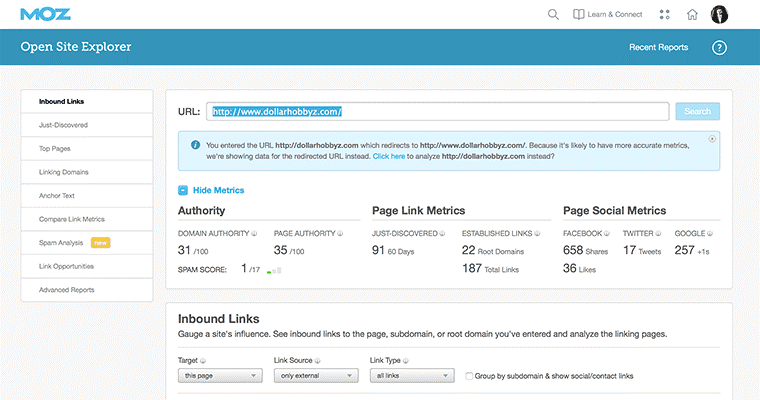
The first two steps helped you identify your main competitors while step 3 will help you describe the process of determining how your competitors rank on the search engines. You may think that analyzing another company’s search engine optimization efforts seems like a very difficult task, but it is crucial for your business to understand their SEO strategies, which can help you adopt your own. Remember, all your competitors are getting high rankings on the keyword sets that you want and the ultimate goal is to surpass your competitor’s search engine results page ranking or begin building an effective plan on how to do it.
It is important to analyze the different backlink profiles of your competition to give you an idea of what they are doing to gain credibility and exposure, which boosts their ranking in Google’s search results. Another tool that you can use to analyze backlink profiles is the Open Site Explorer by Moz. You simply enter the website URL of a competitor into the Open Site Explorer search bar and it will provide you with a great deal of link data that you can use for your own benefit. The first few things that you will readily notice are the domain authority, inbound links, page authority, anchor text and other useful elements.
This may help you get a general idea of a site’s authority but you may still want to go deeper and find the most detailed elements that are giving them the extra boost that takes them to the top results for a specific keyword. One major key element that guides a competitor’s search engine rank is the sources that are linking to them. This means that we have to fully understand the value of these links. The first thing to do when pulling a backlink profile from Open Site Explorer is to determine the type of inbound links you want to examine. You have to take into consideration the 3 aspects before you download the report, and these are target, link source and link type. This will be further explained when you get to Step4.
When you are entering the competitor’s site URL into Open Site Explorer, you have to target the root domain and external links in order to deliver a report, which provides all pages that feature links from that particular domain. You can further narrow it down and make your link analysis much easier by selecting link equity that can provide you with juice-passing, followed links that are very important for SEO. After you have selected all the right criteria, you can now click on Request CSV. After everything has been completed, it will show up under your recent reports. You can now download it and export the file into Excel.
Although the main focus is primarily on the external sources for this process, you should never forget the internal linking because it is still important when building a backlink profile. Those internal links can improve your rankings for keywords if you include them, or their relevant counterparts, in the anchor text of links from pages between your site. It can also allow Google to index the page more quickly and efficiently.
Important things to consider for Step 3:
- Use Open Site Explorer to analyze inbound links
- Target root domain, external links and link equity
- Internal links should be included because they are also important for SEO
Step 4: Identify Feasible Sources
After completing all the technical aspects of the first three steps, you are now more prepared to think more critically about your SEO strategies based on all the reports you have already compiled. Once you have all your competitor’s backlink profile running, it would be a good idea to start organizing the list. Filter and sort out the list so it would be easier for you to really get into the core of the data and set aside the other elements that are insignificant and just cluttering your view. The main elements that you have to focus on are the URL, anchor text and domain authority of these external, equity passing links. If the links look like a spam or a footer link, just disregard it.
A good technical filtering technique to use is sorting the domain authority from largest to the smallest so you can narrow down the number of links you want to view at a time. This can be very useful when you are trying to know which sites would be possible to obtain a link from, based on your domain authority. It is not recommended that you try to reach out to a high DA outlet in order to get most out of your efforts because it is not always realistic. You have to find a DA threshold so you can limit the sources that you can reach out to. For example, if your site has a DA of 70, you may consider a threshold between 55 and 95. Also, it is ideal that you should focus on good quality links that can improve your authority rather than choosing spammy links with lower DA.
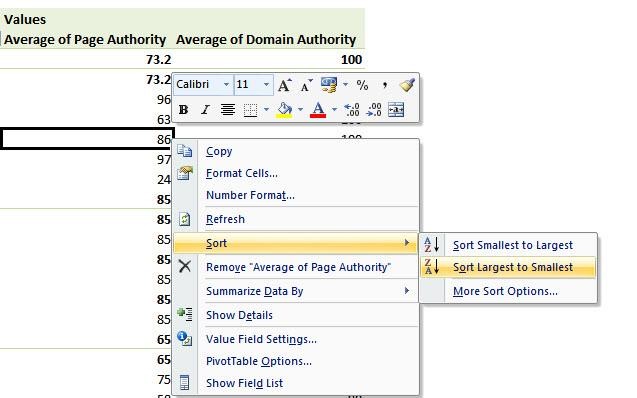
Another advantage of sorting these backlinks is filtering the anchor text. If you are trying to rank for a particular keyword, it would be ideal to have the most anchor text surrounding that keyword and the relevant terms in that keyword set. By doing this, you can assess sources to find out the text they are using when linking to competitor sites and then you must decide if you can contact these possible outlets. Remember to get rid of useless sites such as vendors, agency pages and event pages because it won’t even mention your brands. With the right assessment of the pages, you are on the right track towards compiling a brand new list of contacts.
Important things to consider in Step 4:
- Focus on the URL, anchor text and domain authority
- Delete links which are spammy and questionable
- Filter the links according to DA threshold
- Check anchor text for keyword relevancy
- Delete useless sources
Step 5: Build a List of Targets
Now that you have sorted your competitor’s links from the CSV reports, you can transfer them into an excel sheet. This would be your master sheet and it contains information about each of the sources. You can try to format it but it should generally include descriptive data such as its URL, site name, link anchor text, domain authority, competitor site and the author’s name if possible. Building a master sheet allows you to easily view the possible areas where you can continue to build your own link profile.
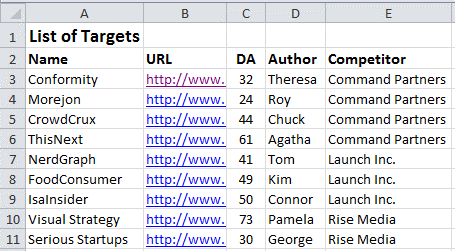
By checking your onsite report, you can see which outlets have already mentioned your brand. This is the opening you need to reach out and tell them that you can offer new content on their site. The report will also show which sites did not feature your brand so you can try to build a relationship with them. You have to make sure that someone in your team or your public relations expert can put this master list into good use. That person or team should understand the SEO value of these links as well as how to get the right amount of SEO value out of any potential placements.
This process of observing your competitors and building your list of targets provides information on where you can improve your linking efforts. Your team can use this as a starting point to get in contact with sources that can link to your page and increase the amount of external links pointing to your domain.
Important points to consider in Step 5:
- Build a list of possible competitors and compile into one document
- It should contain descriptions such as URL, source name, DA, competitor site and author
- Check OSE report for overlaps
- Have your team or public relations expert implement the list
Conclusion
You may think that there are so many tasks to do and it takes a great effort to finish all of these steps. You are probably right because, truthfully, building a backlink profile to improve your rankings on search engines can be very difficult. Most often, we recommend our clients to use other digital marketing alternatives that can deliver better short-term return on investment. They can use search engine marketing, basic PR and email marketing along with SEO. All of these factors can promote your brand and bring it to those people who could link back to you by referencing your work, which provides more traffic and generates revenue while you polish your SEO efforts and move it in the right direction.
Some businesses are often more attracted to advertisements, which guarantee search engine results within a shorter period of time rather than focusing on the gradual building of overall SEO presence while using other digital marketing channels for short term gains. This may be a huge mistake because most companies offering quick solutions often use the “black hat” SEO tactics, which include posting spammy comments, forum posts and cloaked links just to get a good ranking. There may be good results at first but it certainly won’t last long, and it may even damage your brand’s reputation. The quick

